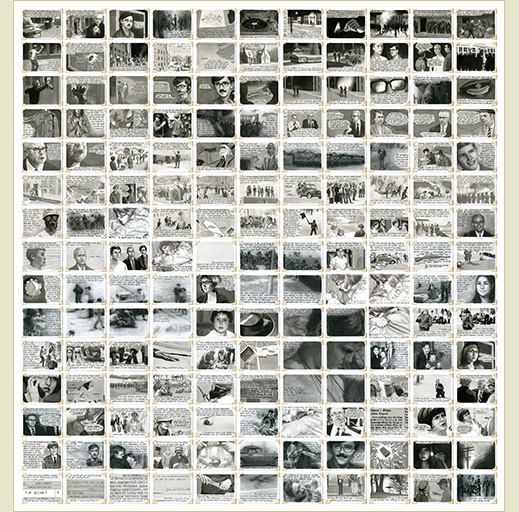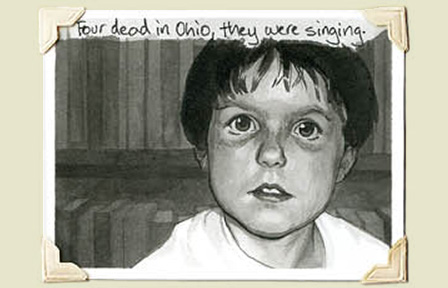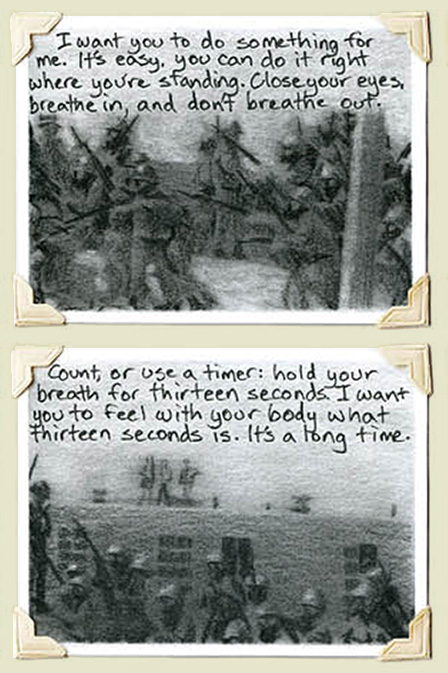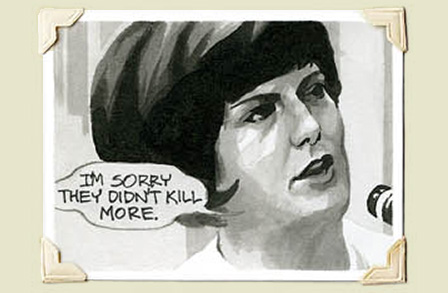No One Is Safe
Created by: Katherine Wirick
Published by: Self-published
Pages: 1



I love the word "serendipitous." And not just for the bald lyricism of the aural quality of bookending a juttering trail of obtruents between the lusty mystery of sibilance. I love it because it evokes a reminder of more than just happy chance, the mere meeting of accidentals. Serendipity dances about the idea of fate without wearing the heavy, tromping boots of anything so serious and world-shaping as Destiny. It's all about the combination of small moments—those instances that seem of little incident but, when mixed, brewed, and then laid out inventively, create a puzzled pattern that wouldn't have come about in any other probable series of events.
Here's a case study.
In January 2013, I partially read Greg Burgas' review of The Nao of Brown, skipping all the bits that dealt with specifics lest I spoil the surprises. I did catch the part where he said that had he read it a couple weeks earlier, it would likely have placed high in his Best of 2012 list (which he published days before reading Nao). That was enough to inspire me to check it out. I was impressed and reviewed the book glowingly, rated it as my book of the year for 2012, and then installed it as my second-favourite comic of all time. I ran a couple book club discussions of the book and turned my preparation notes into a full study guide that proved fairly popular. All this led to my review cropping up fairly well in Google searches—which is how, I'd guess, Emily Thomas found my review. She read Nao much more negatively than I and referenced my review among a few others in her well-heeded and rather sharp critique of Glyn Dillon's book. I didn't entirely agree with her reading of the work but I appreciated the privilege of being able to see the story from another perspective, so I responded in the article's comments. We had a pleasant, diligent back-and-forth and I hope to think I made a friend there (in at least the internet-stranger sense of the term). Along the way, another commenter entered the conversation and joined in the respectful, careful sharing of perspectives. She dropped a note on Twitter to let me know that our exchange was appreciated, even if there was no agreement at the end of the day. I followed a link provided in her profile (because finding out about people is one of the best things in life) and discovered she is an artist and had created a piece of comics art. The samples she posted were beautiful and left me intrigued. I said as much and she offered me a digital review copy.
And so it was that an unexpected chain of events brought me to read one of the coolest comics I've read this year. Serendipitous!
Katherine Wirick's No One Is Safe is, apart from being a well-composed and thoughtful comic, an art piece. Like: art in the gallery-SLASH-museum-SLASH-hang-on-your-wall-and-impress-your-guests sense. The whole comic, in its true form, in the form any of us would be fortunate to witness in person with our own eyes if not handle with our own hands, is a single canvas measuring sixty inches tall and sixty inches wide. A magnificent square divided into a grid of eleven columns and fifteen rows, across which Wirick's story unveils itself. And it's both a story we know as well as a story we've never heard.
 It looks like this, only, you know, big
It looks like this, only, you know, big
Wirick's subjective nonficitonal approach to late-twentieth-century history splits time between telling the story of the National Guard's assault on Kent State University and telling the story of Wirick's father's experience during the National Guard's assault on Kent State University.

And now not everyone can say this but I have read, like, four books on the Kent State shooting. I read them for a research paper in junior high the year after the Challenger disaster. I chose the topic of Kent State for the absolute worst of reasons, though I didn't know it at the time. I decided to write on Kent State because there was an illustration component to the paper and I loved drawing people getting shot. Blame it on Schwartzeneggar movies. Blame it on that brand of sociopathy prominent in thirteen-year-old boys, whether natured or nurtured. It's almost become thematic in my reviews to remark that I was a moron as a young teen.11A quick Google search lends credence to the theory. In any case, while reading No One Is Safe, all the historical notes and my visual sense of the location came rushing back to me—only along with those dried-and-pressed datapoints, a whole new Thing piggybacked its way into my consciousness.
Empathy.
If my moronic youth is one of the chief recurrent themes of my reviews here, the other nail I will never cease pounding on is the talent that literature (and specifically, comics) has for building empathetic connections in readers. When I first encountered the Kent State shooting over twenty-five years ago, the event was hollow, empty of gravity. It held no more sway over my emotions than if you had told me that when the Medes conquered Babylon a fair number of civilians lost their lives. It was nothing. It was so distant from me that it wasn't really twenty-year-old students who had died. It was fictional characters. Not even protagonists, just extras who flit around the background, perhaps meeting their ends in order that the Real Story's plot might be advanced. These kids were fodder for the juggernaut march of history. History.
 These and the two panels that follow (not shown)
These and the two panels that follow (not shown)
comprise one of the more powerful sets in the comic
Even when I sat down to read No One Is Safe, I didn't harbour any sort of relationship with the four who died at Kent State. Even though I no longer find within myself any of that bloodlust desire to see or devise images of war and horror and action-movie violence, I still only knew those four kids as footnotes in history. I'm grateful to Wirick for giving me the opportunity to change that.
 I also, having not learned my lesson, hated this lady.
I also, having not learned my lesson, hated this lady.
I don't know her enough to wish her harm, but man I hated her.
No One Is Safe is an emotional work building its pathos on several foundations. It doesn't as violently tear at one's heart as, say, Twin Spica does, but in being modeled on real life, its agonies seem more present—even if of a more quiet variety. Wirick investigates Kent State, her father's relationship to Kent State, and her own relationship to an ailing father. Her investment seems total. There are moments when the project looks as if it may be too much for her to bear. The reader knows this because as an interruptive narrator, she tells us as much; but these parentheticals, these hiccoughs, are not missteps in her narrative—indeed, the four or five panels in which she breaks from script and invites us into her experience of pain are some of the work's defining moments. Not only are they abrupt breaks in the narrative chain, but they visually take a step away from the project's principal conceit.
Wirick's tremendous five-by-five-foot grid is composed of over 150 separate pieces of paper. They are painted on, drawn on, in such a way as to resemble the photographs we may remember from the '60s—black and white with a quarter-inch of white border. These are fastened to her canvas with those little adhesive corner mounts that were common in all the best photo albums when I was four. Wirick's three stories unfold and untangle and retangle across these "photographs" in a manner that is at once both practiced-and-careful and comfortably fluid. She appears in this work a confident author whose work deserves whatever attention you will afford it. And then she breaks her rules spectacularly.
Avoiding speaking of these instances in too much detail, one will almost immediately take note of several panels that are missing. Places on the canvas that are absent of either mounts or "photos." In their place, Wirick has drawn herself straight onto the canvas. These moments are jarring and important and before I read the work, I wondered if Wirick would earn those moments.22Though I did not have before me the 60" x 60" piece or even one of the 32" x 32" prints that Wirick offers, I tried to approach the piece as near as I would in a gallery setting. I opened my digital review copy on my largest monitor, sat back, and simply observed the piece before I set to the task of investigating its narrative. Immediately, those few patches of distinction jump into view. By presenting the whole thing at a once, Wirick invites readers to view her parade from the bird's perspective—which allows readers to prepare themselves for the very personal experience they'll be taking part in.
In the end that felt like an unfair and abominable question to ask. Do any of us merit the pain we experience, the hurt we express? Am I allowed to be in the kind of position where I can say to you, "Stop crying. It's not as bad as you're making it out to be." Am I allowed to tell you what hurts you? I am not. And so the question of whether Wirick justifies the anguish she expresses is not just meaningless—it's also a bad-faith question asked in the kind of negligence for other persons that allowed Kent State to happen in the first place.33I recognize that some will read this as evasion, as me shying away from answering my earlier question in the negative by my silence. I'll simply say that this is not the case and that I think those several incisive moments work and actually justify the work rather than vice versa. Wirick's pain is her own and that she expresses it in such a way as to involve us, the reading stranger, is a wild thought.

I am fortunate that happenstance conspired to bring No One Is Safe to my attention. I love the work and think myself made better for having seen it. I feel privileged and I'm glad to see once more that comics are a healthy, growing, and wonderfully literate medium. Wirick's art is beautiful and her narrative choices spotless. Even the comic's title, a twist on the Ohio governor's wicked hurtful words, is layered with intent, unveiling itself in stages during and after the story. As I was with Glyn Dillon's Nao of Brown, I'm grateful to author and story for allowing me to experience something special and human. And I'm thankful for the serendipitous path that The Nao of Brown opened up for me. I could have never expected so many wonderful experiences.
Good Ok Bad features reviews of comics, graphic novels, manga, et cetera using a rare and auspicious three-star rating system. Point systems are notoriously fiddly, so here it's been pared down to three simple possibilities:
3 Stars = Good
2 Stars = Ok
1 Star = Bad
I am Seth T. Hahne and these are my reviews.
Browse Reviews By
Other Features
- Best Books of the Year:
- Top 50 of 2024
- Top 50 of 2023
- Top 100 of 2020-22
- Top 75 of 2019
- Top 50 of 2018
- Top 75 of 2017
- Top 75 of 2016
- Top 75 of 2015
- Top 75 of 2014
- Top 35 of 2013
- Top 25 of 2012
- Top 10 of 2011
- Popular Sections:
- All-Time Top 500
- All the Boardgames I've Played
- All the Anime Series I've Seen
- All the Animated Films I've Seen
- Top 75 by Female Creators
- Kids Recommendations
- What I Read: A Reading Log
- Other Features:
- Bookclub Study Guides









